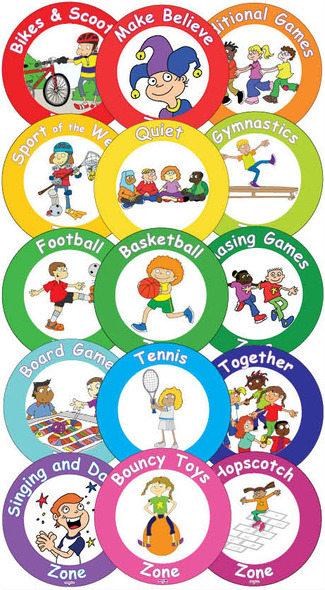Jenny’s High Five – 5 Top Tips for Zoning and Making the Most of your Playground
(Since this article was written, we have been asked for many more different zone signs!
Please Click Here to see our full range!)
Many playground issues – such as fighting, bullying or loneliness – stem from children being bored and lacking the skills they need to make friends, cooperate, take turns and interact with each other. Zoning is simply a way of dividing some of your playground into specific activity areas, making opportunities to help children channel their energies and use their time in imaginative and creative ways. This in turn helps you to make better use of your space and enables the playground to be shared more fairly, preventing bigger games like football from dominating.
1. To help decide which zones will be good for your playground, have a good look at how the space is
currently used – drawing a map is useful and you may find a difference between how staff and children perceive the uses of these areas. Which zones would the children and supervisors like to see? Discussions with the supervisors are crucial here. This encourages participation and provides staff with opportunities to make positive contributions and air any concerns.
2. It is best to start off creating up to three easy-to-manage zones that use simple equipment. Once these become established, you can introduce additional ones. To create clear boundaries between each zone you can use paint, cones, chalk, trees, shrubs or benches. A great way of labelling the different zones is to put up colourful signs like our new purpose-designed and durable Playground Zones signs.
- Quiet Zone: Create a quiet place for children to play quiet games, to read or to just chill out with their friends.
- Traditional Games Zone: We need to keep those traditional playground games alive and this is the perfect way to do just that!
- Clapping Games Zone: Clapping Games are fabulous and create a feeling of camaraderie among those playing.
- Ball Games Zone: Ball games encourage physical exercise and promote positive relationships between children.
- Skipping Zone: Skipping encourages cooperation, trust, turn-taking and team building as well as improving fitness.
- Singing and Dancing Zone: All budding singers and dancers can gather in this zone and take turns to express their artistic natures.
- Chasing Games Zone: Chasing Games are not only great fun, but they release energy and excitement.
- Board Games Zone: Most board games are fun, but there is usually some educational and social benefit to children playing them.
- Make Believe Zone: Children love to pretend, to play act and engage in make believe.
- Craze of the Week Zone: Children love trying out and getting good at crazes old and new.
4. Zoning the playground is such a simple but effective strategy for helping children behave well. When we
create different areas for different activities, this provides additional interest and helps avoid conflict.. Equipment for the zones should be kept in a secure place, and only accessible to the supervisors and Playground Friends. It is cost effective to invest in a lockable shed or large cupboard to keep the equipment in. As with everything else in schools, due to wear and tear, equipment will need to be sorted, cleaned and mended from time to time and some budget will be needed for replacements. Health and safety should be a prime consideration too.
- paint murals;
- plant shrubs and flowers;
- create a vegetable patch;
- involve landscape gardeners to develop areas outside classrooms;
- build activity runs;
- develop nature areas;
- create mosaics;
- develop existing zones like the ‘make believe zone’ which in one of our Golden Schools now includes a small outdoor stage, a beat box for music ad a timer so everyone can have a turn! It is bringing out so much talent!
For enquiries into training for positive lunchtimes and playgrounds please phone 01225 767157 or email circletime@jennymosley.co.uk
For wonderful, colourful and practical playground resources just order a catalogue (01225 767157) or visit our webshop.

